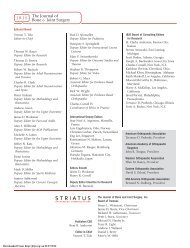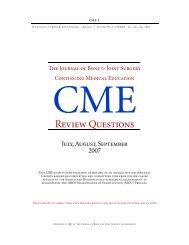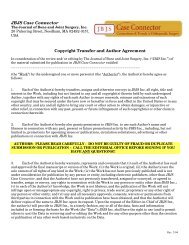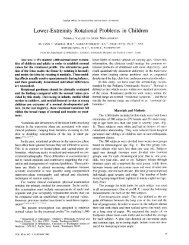Front Matter - The Journal of Bone & Joint Surgery
Front Matter - The Journal of Bone & Joint Surgery
Front Matter - The Journal of Bone & Joint Surgery
Create successful ePaper yourself
Turn your PDF publications into a flip-book with our unique Google optimized e-Paper software.
Three <strong>of</strong> the major bleeding events that occurred by Day 21 were fatal, all due to gastrointestinal hemorrhage<br />
(two patients in the group treated with FRAGMIN and one in the group receiving placebo). Two deaths<br />
occurred after Day 21: one patient in the placebo group died from a subarachnoid hemorrhage that started on<br />
Day 55, and one patient died on day 71 (two months after receiving the last dose <strong>of</strong> FRAGMIN) from a<br />
subdural hematoma.<br />
Patients with Cancer and Acute Symptomatic Venous Thromboembolism<br />
Table 12 summarizes the number <strong>of</strong> patients with bleeding events that occurred in the clinical trial <strong>of</strong> patients with<br />
cancer and acute symptomatic venous thromboembolism. A bleeding event was considered major if it: 1) was<br />
accompanied by a decrease in hemoglobin <strong>of</strong> >2 g/dL in connection with clinical symptoms; 2) occurred at a critical<br />
site (intraocular, spinal/epidural, intracranial, retroperitoneal, or pericardial bleeding); 3) required transfusion <strong>of</strong><br />
>2 units <strong>of</strong> blood products; or 4) led to death. Minor bleeding was classified as clinically overt bleeding that did not<br />
meet criteria for major bleeding. At the end <strong>of</strong> the six-month study, a total <strong>of</strong> 46 (13.6%) patients in the FRAGMIN<br />
arm and 62 (18.5%) patients in the OAC arm experienced any bleeding event. One bleeding event (hemoptysis in a<br />
patient in the FRAGMIN arm at Day 71) was fatal.<br />
Table 12: Bleeding Events (Major and Any) (As treated population) 1<br />
Study period FRAGMIN OAC<br />
200 IU/kg (max. 18,000 IU) s.c. FRAGMIN 200 IU/kg (max 18,000 IU) s.c.<br />
once daily x 1 month, then 150 IU/kg once daily x 5-7 days and OAC<br />
(max 18,000 IU) s.c. once daily x 5 months for 6 months (target INR 2-3)<br />
Number Patients with Patients with Number Patients with Patients with<br />
at risk Major Bleeding Any Bleeding at Risk Major Bleeding Any Bleeding<br />
n(%) n(%) n(%) n(%)<br />
Total during study 338 19 (5.6) 46 (13.6) 335 12 (3.6) 62 (18.5)<br />
Week 1 338 4 (1.2) 15 (4.4) 335 4 (1.2) 12 (3.6)<br />
Weeks 2-4 332 9 (2.7) 17 (5.1) 321 1 (0.3) 12 (3.7)<br />
Weeks 5-28 297 9 (3.0) 26 (8.8) 267 8 (3.0) 40 (15.0)<br />
1Patients with multiple bleeding episodes within any time interval were counted only once in that interval. However,<br />
patients with multiple bleeding episodes that occurred at different time intervals were counted once in each interval<br />
in which the event occurred.<br />
Thrombocytopenia: See WARNINGS: Thrombocytopenia.<br />
Other: Allergic Reactions: Allergic reactions (i.e., pruritus, rash, fever, injection site reaction, bulleous eruption)<br />
have occurred rarely. A few cases <strong>of</strong> anaphylactoid reactions have been reported. Local Reactions: Pain at the<br />
injection site, the only non-bleeding event determined to be possibly or probably related to treatment with FRAGMIN<br />
and reported at a rate <strong>of</strong> at least 2% in the group treated with FRAGMIN, was reported in 4.5% <strong>of</strong> patients treated<br />
with FRAGMIN 5000 IU once daily vs 11.8% <strong>of</strong> patients treated with heparin 5000 U twice daily in the abdominal<br />
surgery trials. In the hip replacement trials, pain at injection site was reported in 12% <strong>of</strong> patients treated with<br />
FRAGMIN 5000 IU once daily vs 13% <strong>of</strong> patients treated with heparin 5000 U three times a day.<br />
Ongoing Safety Surveillance: Since first international market introduction in 1985, there have been more than<br />
15 reports <strong>of</strong> epidural or spinal hematoma formation with concurrent use <strong>of</strong> dalteparin sodium and spinal/epidural<br />
anesthesia or spinal puncture. <strong>The</strong> majority <strong>of</strong> patients had postoperative indwelling epidural catheters placed for<br />
analgesia or received additional drugs affecting hemostasis. In some cases the hematoma resulted in long-term or<br />
permanent paralysis (partial or complete). Because these events were reported voluntarily from a population <strong>of</strong><br />
unknown size, estimates <strong>of</strong> frequency cannot be made.<br />
Post-Marketing Experience: Skin necrosis has occurred rarely. <strong>The</strong>re have been isolated cases <strong>of</strong> alopecia reported<br />
that improved on drug discontinuation.<br />
OVERDOSAGE<br />
Symptoms/Treatment: An excessive dosage <strong>of</strong> FRAGMIN Injection may lead to hemorrhagic complications. <strong>The</strong>se<br />
may generally be stopped by the slow intravenous injection <strong>of</strong> protamine sulfate (1% solution), at a dose <strong>of</strong> 1 mg<br />
protamine for every 100 anti-Xa IU <strong>of</strong> FRAGMIN given. A second infusion <strong>of</strong> 0.5 mg protamine sulfate per 100<br />
anti-Xa IU <strong>of</strong> FRAGMIN may be administered if the APTT measured 2 to 4 hours after the first infusion remains<br />
prolonged. Even with these additional doses <strong>of</strong> protamine, the APTT may remain more prolonged than would usually<br />
be found following administration <strong>of</strong> conventional heparin. In all cases, the anti-Factor Xa activity is never completely<br />
neutralized (maximum about 60 to 75%). Particular care should be taken to avoid overdosage with protamine sulfate.<br />
Administration <strong>of</strong> protamine sulfate can cause severe hypotensive and anaphylactoid reactions. Because fatal<br />
reactions, <strong>of</strong>ten resembling anaphylaxis, have been reported with protamine sulfate, it should be given only when<br />
resuscitation techniques and treatment <strong>of</strong> anaphylactic shock are readily available. For additional information, consult<br />
the labeling <strong>of</strong> Protamine Sulfate Injection, USP, products. A single subcutaneous dose <strong>of</strong> 100,000 IU/kg <strong>of</strong> FRAGMIN<br />
to mice caused a mortality <strong>of</strong> 8% (1/12) whereas 50,000 IU/kg was a non-lethal dose. <strong>The</strong> observed sign was<br />
hematoma at the site <strong>of</strong> injection.<br />
Rx only<br />
U.S. Patent 4,303,651<br />
April 2007 FR080231 © 2007 Pfizer Inc.<br />
818 312 112 All rights reserved. Printed in USA/July 2007<br />
<br />
<br />
<br />
<br />
<br />
<br />
<br />
<br />
<br />
<br />
<br />
<br />
<br />
<br />
<br />
<br />
<br />
<br />
<br />
<br />
<br />
<br />
Downloaded From: http://jbjs.org/ on 01/27/2014
















